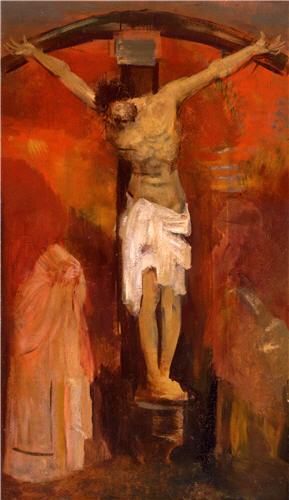The Crucifixion by Odilon Redon is a diminutive yet extraordinarily striking painting. It is believed to have been painted in 1904, and is just one of a number of paintings that were produced by the artist during the early part of the twentieth century. The painting is based on a much earlier, and far more gruesome work by the German artist Matthias Grünewald.
The painting consists of just three images, the main central figure of Christ on the cross, then just visible on the left-hand side of the painting is the shadowy, grieving figure of Mary. Whilst on the right-hand side is the barely discernible, wraith-like figure of St John. No other figures or buildings were to be seen. The desolate and vividly coloured background is just an abstract layered patchwork of blurred red, orange, brown and yellow oil paint and pastel.
I was immediately struck when viewing the painting for the first time by the colours, and by the hugely strong emotional content that has been captured by the artist. A comment that I read whilst researching in the Barber Institute’s archives for the painting mentioned how ‘the Redon still glows in my mind’s eye’.
A piece of music that I have listened to a lot recently is Arvo Pärt’s minimalist composition ‘Passio’. This is a piece that was composed as a meditation on the text of St John that tells the story surrounding Christ’s trial and subsequent death. A piece very fitting for the painting that I have chosen to compose for.
My composition starts very quietly and sparsely, gradually building in layers of swirling vocalesque sounds. I love working with sound in a way that it imitates the human voice. My piece is very minimal, echoing the minimal character of the painting. I am also attempting to capture the emotion portrayed, though in a symbolic and meditative manner.

Hi Kevin! As I told you, I feel that your piece is inviting us to stay in front of the painting for a little longer. The harmony is fascinating. I’m really excited to hear your piece at the Barber.
LikeLike
Using magnetic tape as your original recording medium will certainly have given your composition a certain sound which is not often found in modern electroacoustic music. I really like the idea of producing a composition which is intended to have a mediative effect in conjunction with the painting; it’s innovative and allows the two pieces to work in synergy with each other.
LikeLike